
Concept explainers
To find: The sketch for the graph of the function, and approximate the root feature to approximate the real zeroes of the function.
Answer to Problem 92E
Thesketch for the graph is shown in Figure 10 andzero at
Explanation of Solution
Given:
The given polynomial function is
Calculation:
The graph for
The first step is to on the calculator and press Y= button to access the Y= editor.
The required display is shown in Figure 1
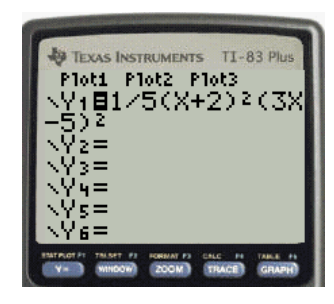
Figure 1
The second step is to set the range by pressing the Window, it is to be noted that there should be the negative sign with the window at the start of the expression comes from minus sign of the bracket that is to the left of the ENTER button.
The required display is shown in Figure 2
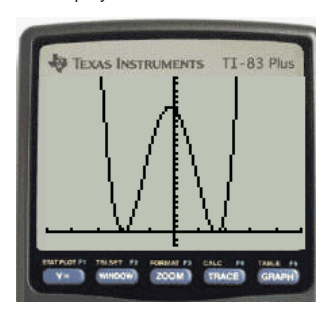
Figure 2
The third step is to press graph.
The required display for the graph is shown in Figure 3
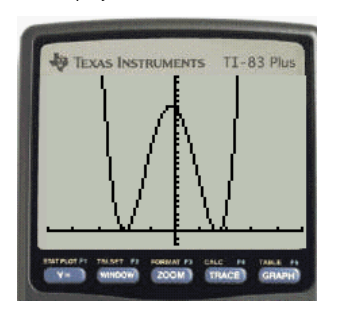
Figure 3
The fourth step is to Press TRACE to determine the x intercepts if the graph.
The required display for the graph is shown in Figure 4
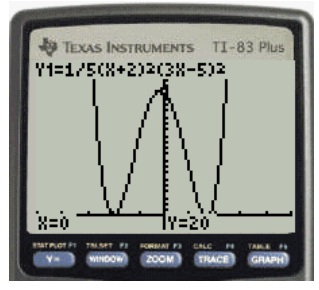
Figure 4
The fifth step is to Press the yellow coloured key to the find the graph functions and then select ZERO in the second line followed by ENTER press.
The required display for the graph is shown in Figure 5
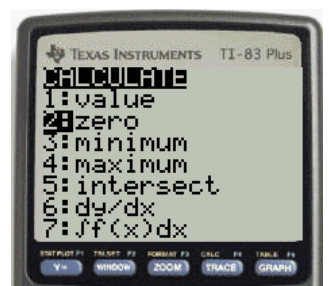
Figure 5
The step six is that if the graph is displayed with the left bound at the bottom left coroner press the arrow key or the enter value to select the x value for the left bound of the interval then press enter.
The required display for the graph is shown in Figure 5
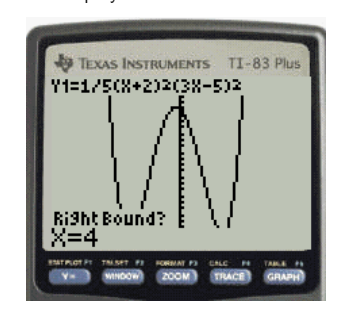
Figure 6
The step seven is that If the graph is displayed with the right bound in the bottom left then press the arrow key to select the value of the right bound of the interval and then press enter.
The required display for the graph is shown in Figure 7
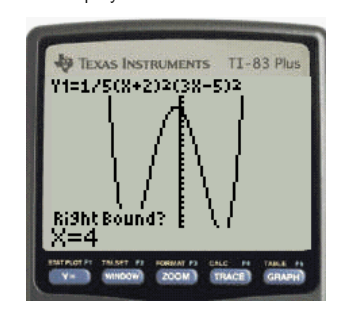
Figure 7
The step eight is that If the graph is displayed with the Guess at the bottom left corner than press the arrow key or the enter value to select the point near the zero of the function, that is between the bounds and then press enter.
The required display for the graph is shown in Figure 8
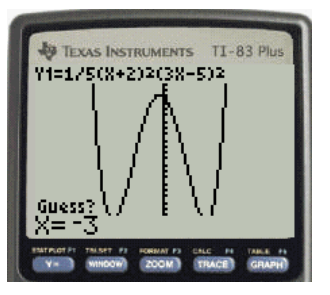
Figure 8
The step nine is that the x axis intercept nearest to the value of the guess is displayed with the coordinate. Therefore the x intercept is at
The required display is shown below.
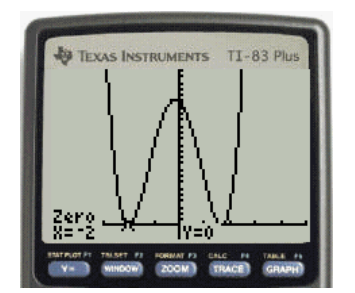
Figure 9
The step ten is to repeat from step five to eight and with the guess for the other value of the x axis intercept and the another x intercept is
The required display is shown below.
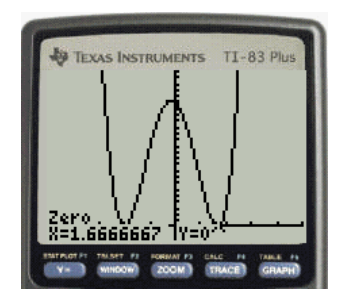
Figure 10
The graph touches the x axis at
Then, the multiplicity of zero at
Chapter 2 Solutions
Precalculus with Limits
- 48. f(x) = { 4 x if x < 2 2x 2 if x 2arrow_forwardГ 49. -x+1 if x 1 Answer ->arrow_forwardA Content X MindTap - Cengage Learning x Function Evaluations x + /ui/evo/index.html?elSBN=9780357038406&id=339416021&snapshotld=877369& GE MINDTAP , Limits, and the Derivative ⭑ វា a ANSWEI 16. Refer to the graph of the function f in the following figure. कर्ट AA C 54 -3-2 7 7 Ay 6. S 5. y=f(x) 4 3. 2. 1 -3- 34567 8 00 9 10 a. Find the value of ƒ (7). b. Find the values of x corresponding to the point(s) on the graph of ƒ located at a height of 5 units from the x-axis. c. Find the point on the x-axis at which the graph of ƒ crosses it. What is the value of f (x) at this point? d. Find the domain and range of f. MacBook Pro G Search or type URL + > % Λ & 5 6 7 29 ( 8 9 0arrow_forward
- Morgan F. - C X A Courses MindTap - Cengage Learning Х Domain of Square Roots X + gage.com/static/nb/ui/evo/index.html?elSBN 9780357038406&id=339416021&snapshotld=877369& CENGAGE MINDTAP 2: Functions, Limits, and the Derivative 47. x if x < 0 f(x) = 2x+1 if x 0 Answerarrow_forwardA Content MindTap - Cengage Learning × Function Evaluations * + c/nb/ui/evo/index.html?elSBN 9780357038406&id=339416021&snapshotld=877369& GAGE MINDTAP ions, Limits, and the Derivative 15. Refer to the graph of the function f in the following figure. 6 y = f(x) 5 4+ 3- 2- 1 + 2 -1 3 4 5 6 a. Find the value of ƒ (0). Answer-> b. Find the value of x for which (i) f (x) = 3 and (ii) f (x) = 0. Answer ▾ c. Find the domain of f. Answer + d. Find the range of f. Answer+ MacBook Proarrow_forwardAnswer-> 12. Let g be the function defined by Find g(-2), g(0), g (2), and g (4). - +1 if x <2 g(x) = √√√x-2 if x 2arrow_forward
- 13. Let f be the function defined by Find f (-1), f (0), ƒ (1) and ƒ (2). Answer f(x) = .2 J-x² +3 if x <1 2x²+1 2x²+1 if x ≥ 1arrow_forwardΛ Content Mind Tap - Cengage Learning × Function Evaluations x + c/nb/ui/evo/index.html?elSBN 9780357038406&id=339416021&snapshotld=877369& GAGE MINDTAP ons, Limits, and the Derivative 14. Let f be the function defined by Find f (0), f (1), and f (2). 2+1 x if x 1 if x 1 f(x) = 1 1-xarrow_forwardA Content c/nb/ui/evo/index.html?elSBN 9780357038406&id=339416021&snapshotld=877369& GAGE MINDTAP ons, Limits, and the Derivative 11. Let f be the function defined by Find f (-2), f (0), and f (1). Answer f(x) = [ x² + 1 if x ≤ 0 if x > 0arrow_forward
- Given that 4−4i is a zero, factor the following polynomial function completely. Use the Conjugate Roots Theorem, if applicable. f(x)=x4−5x3−2x2+176x−320arrow_forwardeliminate the parameter to find the cartesian equation of the curve and sketch the graph. On the graph show the direction it takes and the initial and terminal point. Please draw by hand and show how you got to each steparrow_forwardeliminate the parameter to find the cartesian equation of the curve and sketch the graph. On the graph show the direction it takes and the initial and terminal point. Please draw by hand and show how you got to each steparrow_forward
 Calculus: Early TranscendentalsCalculusISBN:9781285741550Author:James StewartPublisher:Cengage Learning
Calculus: Early TranscendentalsCalculusISBN:9781285741550Author:James StewartPublisher:Cengage Learning Thomas' Calculus (14th Edition)CalculusISBN:9780134438986Author:Joel R. Hass, Christopher E. Heil, Maurice D. WeirPublisher:PEARSON
Thomas' Calculus (14th Edition)CalculusISBN:9780134438986Author:Joel R. Hass, Christopher E. Heil, Maurice D. WeirPublisher:PEARSON Calculus: Early Transcendentals (3rd Edition)CalculusISBN:9780134763644Author:William L. Briggs, Lyle Cochran, Bernard Gillett, Eric SchulzPublisher:PEARSON
Calculus: Early Transcendentals (3rd Edition)CalculusISBN:9780134763644Author:William L. Briggs, Lyle Cochran, Bernard Gillett, Eric SchulzPublisher:PEARSON Calculus: Early TranscendentalsCalculusISBN:9781319050740Author:Jon Rogawski, Colin Adams, Robert FranzosaPublisher:W. H. Freeman
Calculus: Early TranscendentalsCalculusISBN:9781319050740Author:Jon Rogawski, Colin Adams, Robert FranzosaPublisher:W. H. Freeman
 Calculus: Early Transcendental FunctionsCalculusISBN:9781337552516Author:Ron Larson, Bruce H. EdwardsPublisher:Cengage Learning
Calculus: Early Transcendental FunctionsCalculusISBN:9781337552516Author:Ron Larson, Bruce H. EdwardsPublisher:Cengage Learning





